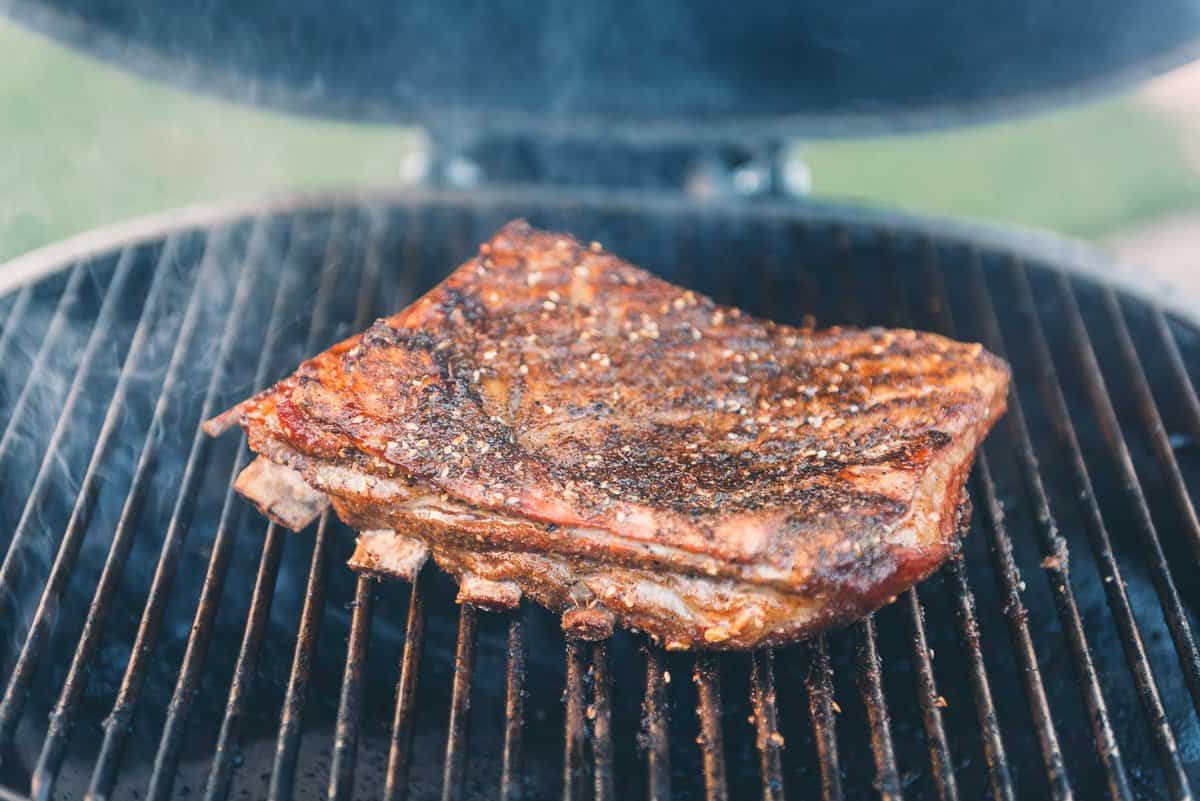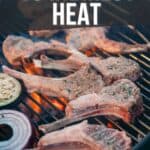Direct heat vs Indirect heat – What’s the difference? In this guide, we’ll break down how to use both direct and indirect heat for a seamless grilling experience.
Achieving master-level barbecue status means understanding when to use direct vs indirect heat on your grill or smoker to properly sear, slowly roast, prevent burning, and nail the ideal doneness based on the cut of meat.
Save This Guide ✉️
Enter your email below, and I’ll send this guide straight to your inbox.
Plus, I’ll send you great new recipes fresh outta the oven.
If your mind spins every time you hear the terms direct and indirect heat, you’re not alone. While popular terms in the grilling world, they can be difficult to understand for newer grillers. But we’re breaking down the difference between the two so you can level up your favorite grilling recipes.
TL;DR direct heat Vs indirect heat
Understanding the distinction between direct and indirect heat is crucial for achieving optimal results in your grilling recipes.
Direct heat gives you that good sear and quick cooking for certain foods.
Indirect heat lets you slow-cook large pieces of meat or more delicate foods without the risk of charring.
Mastering when to use each method ensures that you have precise control over the cooking process, leading to perfectly grilled dishes every time.
What Is Direct Heat?
Grilling with direct heat refers to the cooking method where food is cooked directly over the heat source.
In this setup, the direct heat source is usually located directly below the grates where the food sits. Direct exposure to the flames or hot coals ensures that the food gets that coveted caramelization, the Maillard reaction, and grill marks. It’s a go-to technique for quick-cooking foods that benefit from high, direct heat.
Pros & Cons of direct heat grilling
Direct heat grilling comes with several advantages.
- It’s quick, making it perfect for those moments when you’re craving a speedy, flavorful meal.
- It imparts a delightful char and smoky flavor to the food, enhancing its overall taste.
- The direct exposure to very high heat also creates that coveted sear on meats, locking in juices and creating a visually appealing presentation.
However, the rapid cooking can be a double-edged sword. While it’s excellent for certain dishes, it may lead to uneven cooking or burning for thicker cuts. It’s the superhero for most steak recipes, but it will struggle with a massive turkey leg.
Best practices for using direct heat
To make the most of direct heat grilling, it’s essential to preheat the grill thoroughly before adding any food to the grill grates.
- Ensure the grates are clean and well-oiled to prevent sticking.
- If your grill allows, consider adjusting the height of the grates for even cooking.
- Always let the grill preheat to a good, even temperature, usually to 400 or above, for cooking on the hot side of the grill.
Keep a close eye on the food, as direct heat can lead to quicker cooking times, and flipping or rotating items can help achieve an evenly cooked result. However, because you are right over the coals, flare-ups are more likely to happen. Always use long grilling tongs and proper grilling safety to avoid any issues.

Typical foods ideal for direct heat grilling
- Steaks: Direct heat is perfect for steak recipes, creating a flavorful crust on the outside while maintaining a juicy interior. If you’re steak is thicker than 1 1/2″ thick, keep reading for why you may want to combo direct and indirect cooking.
- Hamburgers: Burgers benefit from the quick, intense heat, developing a charred exterior and a succulent inside.
- Hot dogs: Direct heat gives hot dogs that classic grill flavor with a slightly crispy skin.
- Shrimp: Since shrimp cook quickly, they are perfect for a hot and fast cook. Just make sure to clean the grill and oil the grill grates to avoid the grilled shrimp from sticking.
- Lamb chops: Because lamb chops have been cut for individual portions, they are perfect for cooking hot and fast to get a good sear on the outside while keeping the inside medium rare.
Our favorite hot and fast Grilling Recipes

What Is Indirect Heat?
On the flip side, grilling with indirect heat involves cooking food away from the heat source.
In an indirect setup, also known as a two-zone fire, the heat source is on one side of the grill, and the food is placed on the other.
This allows for a more gradual cooking process, preventing the exterior from burning while ensuring the interior is thoroughly cooked. You see this a lot when smoking, where meat needs a long time over the heat to break down and get tender.
Advantages & Disadvantages of indirect heat grilling
Indirect heat grilling comes with a set of advantages. Firstly, it’s excellent for cooking large cuts of meat or whole items, ensuring they cook through without burning on the outside. Secondly, it’s the go-to for achieving that coveted smoky flavor, especially when using wood chips or chunks. Lastly, it’s a lifesaver when dealing with delicate items that might fall apart or dry out under direct heat.
However, indirect grilling is more of a slow cooking method, which requires patience. While the results are often worth it, it might not be the best choice for the impromptu weeknight barbecue.
Best practices for using indirect heat
To master indirect heat grilling, it’s essential to set up a two-zone cooking area on your grill. Place the heat source on one side and arrange the food on the other, a hot zone and a cool zone. Keep the grill lid closed to create a convection oven-like environment, circulating heat around the food. This method provides a controlled cooking environment, preventing flare-ups and allowing for slow, steady cooking.

Typical foods ideal for indirect heat grilling
- Whole chickens: Indirect heat ensures the chicken cooks evenly without the risk of burning, resulting in juicy and flavorful meat, like our grilled spatchcock chicken and smoked whole chicken.
- Ribs: Slow-cooking ribs over indirect heat allows the meat to become tender and infused with smoky goodness, like our smoked spare ribs and smoked lamb ribs.
- Vegetables: Delicate vegetables, like bell peppers and mushrooms, benefit from the indirect method, preventing them from turning mushy and maintaining their natural flavors, like our grilled corn on the cob and smoked cabbage.
Our best Low and Slow Recipes for Indirect Grilling

Tips for Mastering Direct and Indirect Heat Grilling
Consider the type of food you’re grilling – thinner cuts thrive under direct heat, while bigger roasts prefer the indirect method. Factor in the time you have; if you’re in a hurry, direct heat might be your ally. Take note of your equipment, as most grills allow you to have different zones for both methods.
How to create direct heat zones on a grill
Creating a direct heat zone on your grill is as simple as concentrating your heat source in one area. For charcoal grills, this means placing a higher quantity of hot charcoal or charcoal briquettes on one side of the grill. If you used a charcoal chimney starter, you can do this step by dumping the coals into your grill.
This creates a 2-zone fire, a hot side (direct heat) and a cooler side (indirect heat). Alternatively, if you can spread lit coals over the entire grilling area but know you won’t be able to move food to a cooler part of the grill if needed.
On a gas grill, place food over burners that have been turned on.
How to create indirect heat zones on a grill
To establish an indirect heat zone, position your food away from the primary heat source. For grilling on a charcoal grill, this involves placing the food on the side opposite the hot coals (direct heat). For grilling on a gas grill, turn off the burners on one side of the grill so that you have a hot zone and a cooler zone.
Combo Method of direct and indirect heat for optimal grilling
Many grilling recipes benefit from a combo cooking method of both direct and indirect heat. This technique allows you to sear the exterior of your food over direct heat and then finish cooking it more gently over indirect heat. For instance, sear a steak on high heat first to lock in juices, then move it to the indirect side to reach the desired internal temperature without burning the exterior.
Alternatively, we often use the reverse sear method, where we let a piece of meat cook over the cooler side of the grill before finishing it with a sear to create an amazing crust.

Safety precautions to take when grilling with direct or indirect heat
Grilling safety is always a must.
- When grilling with direct heat, always be cautious of flare-ups, especially with fatty meats.
- Keep a close eye on your food, and have a spray bottle of water handy to tame any flames.
- For indirect heat, ensure your grill is well-ventilated and manage the airflow to prevent a buildup of too much smoke.
- Additionally, use long-handled grilling tools to avoid burns, and never leave a hot grill unattended.
More helpful Grilling Guides
Understanding the difference between direct and indirect heat can make a world of difference for your grilling recipes. While direct heat is more suited to quick cooks, indirect cooking is better for slow cooking. The best way to master these two heat methods is to experiment for yourself. Use whatever grill you’ve got and you’ll learn the ins and outs of direct and indirect heat in no time!


